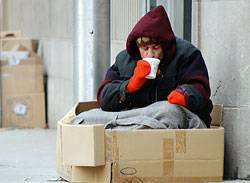
The homeless population is changing. In the days of the Great Depression, many homeless people were victims of bad luck and a worse economy. But after studying St. Louis’ homeless population since the 1980’s, experts at Washington University School of Medicine in St. Louis say the problem has become more complex in recent times. Their results are helping to dispel myths about homelessness and to raise concerns about the psychiatric health of this population.
When the researchers first began their series of studies, many experts believed most homeless people had schizophrenia or bipolar disorder and had ended up on the streets after being discharged from mental hospitals or other facilities. But in a study conducted at the end of the 1980s, the Washington University team found that only two out of 900 homeless people in St. Louis had been deinstitutionalized. And the most common psychiatric problem wasn’t schizophrenia. It was substance abuse, followed by clinical depression.
“This is not to say that people with schizophrenia and bipolar disorder aren’t overrepresented in the homeless population,” says David Pollio, Ph.D., associate professor of social work at Washington University’s George Warren Brown School of Social Work. “The rate of schizophrenia is between 5 and 10 percent, which is much higher than the 1 to 2 percent rate in the general population, but it still is a minority.”
As the 21st century begins, alcohol and drug abuse remain the predominant problems for the homeless, but several things have changed. At the start of the 1980s, the majority of homeless people in St. Louis were white males. Now, most are ethnic minorities, and the numbers of women and children have increased dramatically.
Abuse of illegal drugs also has increased, and the most popular drug these days wasn’t even a factor in the homeless population 20 years ago.

“When we look at the homeless back in 1980, cocaine use was virtually nonexistent,” says principal investigator Carol S. North, M.D., professor of psychiatry at Washington University School of Medicine. “It’s clearly the drug of choice today. And it’s not just any form of cocaine. Homeless people who abuse cocaine almost unanimously use crack cocaine.”
North says the prevalence of psychiatric illness, including substance abuse and dependence, is on the rise in the homeless population. She says it is important that service agencies be aware of those changes and how they will affect the needs of homeless people.
According to North, drug and alcohol abuse are not solely to blame for homelessness, but she says they may contribute to vulnerability in a major way. The research team found that almost 88 percent of alcohol-abusing homeless men and 84 percent of homeless women who abuse alcohol were diagnosed with an alcohol use disorder in the year before they became homeless. For drug abuse, 78 percent of men and 69 percent of women received a diagnosis during the year before they lost housing.
But not every alcoholic or drug abuser becomes homeless, and not every patient with schizophrenia ends up on the street. North and Pollio say homelessness is a complex problem with multiple causes.

“Many factors increase vulnerability,” Pollio says. “Unfortunately, they tend to be things associated with being very poor and susceptible to a variety of human miseries, like family problems, poor employment and education or a history of abuse or neglect.”
North says those vulnerabilities combine with external factors to put a person on the street. She believes homelessness is something nobody deserves. And at this time of year as charities raise money for the homeless, she can’t think of any group more deserving of assistance.
However, North and Pollio warn that how people provide assistance is important. They say you may want to think twice when a homeless person approaches asking for cash.
“When I have the time, I will go with a homeless person to get a cup of coffee or to help them get on a bus.” Pollio says. “But as a rule, I don’t just give that person cash.”
They say a better alternative might be to send cash to an agency that assists homeless people. That way, they say the chances are much higher the money will be used to assist the homeless and not spent in a way that could exacerbate a particular homeless person’s problems.
North CS Eyrich KM, Pollio DE, Spitznagel EL. Are rates of psychiatric disorders in the homeless population changing? American Journal of Public Health, vol. 94:1, pp. 103-107, January 2004.
North CS, Pollio DE, Smith EM, Spitznagel EL. Correlates of early onset and chronicity of homelessness in a large urban homeless population. Journal of Nervous and Mental Disease, vol. 186:7, pp. 393-400, 1998.